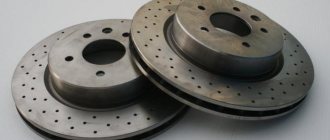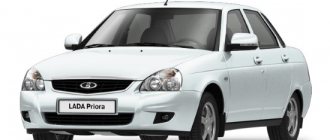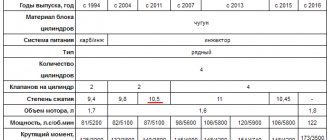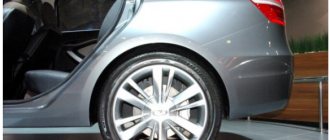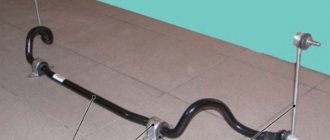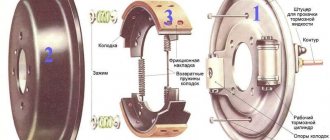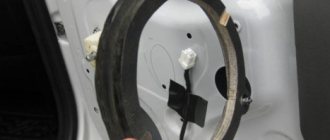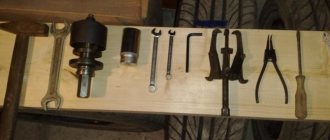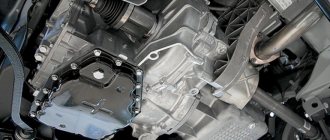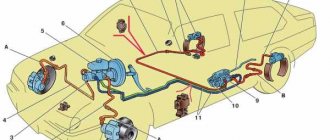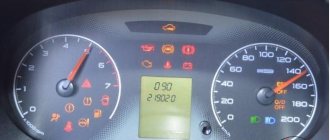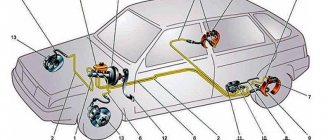The braking mechanism consists of several parts and differs in two types of design.
The disk unit has an open design, allowing the device to operate for a long time without overheating. When you press the brake pedal, the brake pads are pressed against the disc mounted inside the wheel rim using a caliper. The degree of compression of the disc by the calipers is very high, which allows the car to brake more efficiently. As a result of heavy loads, the mechanism has a relatively short resource.
The drum mechanism has a closed cylindrical body, which prevents the entry of dirt and dust and has a long working life. The brake pads are pressed against the inner surface of the drum, causing the car to stop. The pressing force of the elements is comparatively lower than that of analogues with a disk, therefore such mechanisms are considered less effective.
The combination of front discs and rear drums is optimal in terms of efficiency and durability. This version of the Lada Vesta justifies itself with its reasonable price and reliability.
Pads and their articles for the disc mechanism of the rear brake system of Lada Vesta
1400 rubles per set
As such, there have been no complaints about these spare parts from Lada Vesta owners; we can also note the budget price tag and the relatively high quality of the pads from this manufacturer. Therefore, we recommend purchasing pads installed at the factory.
The pads on the disc brake mechanism are replaced with
20-30 thousand kilometers, this number is individual and depends on the driving style of a particular driver, so when replacing rear pads it is not recommended to focus only on mileage. When the pads wear out, you will definitely feel a deterioration in braking, and in rare cases, an extraneous sound may appear. In addition, pay attention to the operation of the hand brake; situations when the hand brake does not hold the car weakly indicate severe wear of the rear brake system.
The procedure for replacing the rear pads is not much different from the front ones, so you can use the instructions from the article on replacing the front pads. The only difference is the handbrake cable connected to the caliper, but it does not in any way interfere with the work of replacing the brake mechanism.
Lada Vesta with a 1.6 liter engine is equipped with drum brakes, as a result of which the pads and part numbers will differ. In addition, replacing them will be labor-intensive. Pads on such a system last longer than disc ones, their service life is average
100 thousand kilometers, again this figure varies depending on the driver’s driving style. In some cases, the pads wore out only after 200 thousand kilometers.
DSC_9303
Before assembly, completely screw in the rear end of the spacer bar so that its length becomes minimal.
Before assembly, completely screw in the rear end of the spacer bar so that its length becomes minimal.
Install new rear wheel brake pads in reverse order.
Before installing the brake drum, clean its working surface with a wire brush to remove dirt and wear products from the pads.
Minuses
Drivers say that the front discs wear out very quickly on any version of Vesta. You have to change them at 50 thousand km or earlier.
This depends on the operating mode. If the car is used in a city with rapid acceleration and braking, then the wheels can be worn out within 30,000 km. If the driving is mostly suburban and quiet, then you can drive 150 thousand km or more. But you shouldn’t see this as a problem, because the main thing is that the car brakes effectively. My car is 6 months old, I have driven 6000 km.
If you have already replaced the wheels on your car, share your opinion in the comments at what mileage this happened. If they are not worn out yet, then write what kind of car you have and how worn the discs are.
Components
In such a situation, there are 2 scenarios:
- Carry out modifications in accordance with the factory diagram;
- Purchase components from another manufacturer.
IMPORTANT! Unauthorized modifications to the design of the car's braking system, which includes the independent installation of rear disc brakes on the Lada Vesta, can be regarded as a violation of traffic rules. And so, one of the owners of the Lada Vesta in the Exclusive configuration said that he was able to find out from an AvtoVAZ employee exactly what components were needed to replace drum brakes with disc brakes
And so, one of the owners of the Lada Vesta in the Exclusive configuration said that he was able to find out from an AvtoVAZ employee exactly what components were needed to replace drum brakes with disc brakes.
According to an employee of the plant, there is no need to replace the beam or reflash the ABS block, and this significantly speeds up and reduces the cost of the work.
In addition, the picture clearly shows that there is a standard spacer between the axle and the beam and it is to this spacer that the boot is fixed. From the factory, the hub and disc come separately, so after installing the rear disc brakes on the Lada Vesta yourself, there is no need to replace the bearings if you need to replace the disc.
All the components necessary to replace the brakes with your own hands are presented in the table along with the article numbers.
| Position | vendor code |
| Right brake hose mounting bracket | 8450031136 |
| Left brake hose mounting bracket | 8450031137 |
| Rear brake flexible hose assembly – 2 pcs. | 8450031129 |
| Rear brake pads (full set) | 11196-3502089-00 |
| Washer 10 | 00001-000516870 |
| Ball joint fixing bolt | 21080-2904194-00 |
| Washer 10 | 00001-000516870 |
| Ball joint fixing bolt | 21080-2904194-00 |
| Rear left brake (assembly) | 8450031163 |
| Rear right brake (assembly) | 8450031162 |
| Retainer fixing screw | 21080610526810 |
| Rear brake disc | 8450031131 |
| Rear wheel hub (assembly) | 8450031130 |
| Hex Head Screw | 00001-003836021 |
| Right rear brake guard | 8450031686 |
| Left rear brake guard | 8450031687 |
| Bolt M10-1.25-40 | 8450031161 |
| Left rear brake mount | 8450031132 |
| Right rear brake mount | 8450031133 |
The estimated cost of the entire kit for self-installation of rear disc brakes on a Lada Vesta is about 30,000 rubles.
Signs of pad wear
Before each vehicle departure, check the amount of fluid in the brake system reservoir. The level must be above the min mark. If it is lower, this is one of the signs of abrasion.
Another sign is that the pedal softens at first and then drops. The distance from pressing the pedal to stopping the car increases noticeably.
If such signs, knocks and squeaks are detected, the pads are inspected. Check whether their wear has reached the limit values. For overlays the thickness limit is 2 mm. The maximum size of the drum rubbing surface is 204.45 mm.
The best manufacturers, brands, analogues
The working brake system in a car is for the safety of the driver, passengers, and other road users. The basis of the design is:
During systematic use, parts wear out, linings wear out, and braking efficiency decreases. The process of preventing the brake circuit is simple, but requires attentiveness on the part of the technician.
Vesta and Grant drums and differences in design
It’s impossible to look at what rear brakes are installed on the Lada Vesta now without being surprised. We remove the wheel and see: there are no fastening elements on the body.
Rear drum, serial Lada Vesta
In fact, one element will be hidden under the hood. Break off the cap and everything will become clear.
You will need a 30mm spanner, but don’t rush! First of all, to remove the drum, you need to do the following:
- Release the handbrake;
- Use a thin screwdriver to rotate the ratchet upward to bring the pads together.
The required hole is one of four
The ratchet in the brake drum regulates the adjustment of the unit as a whole. But there is no need to remember how many revolutions were made. On the contrary, before installation, the adjustment is set to a minimum.
If even rear disc brakes were installed on the Lada Vesta, everything would be simpler than with a “new drum design”. The drums on the Lada Grant are different.
Granta and its rear brakes
Previously, two studs were unscrewed, and that was enough. The ABS sensor was also easy to remove: disconnect the connector and unscrew the screw. On Vesta this option is not provided.
It was decided before the design stage whether to install drum or disc rear brakes on the Lada Vesta. Too many changes have appeared in the design of drums - and they can only be made through painstaking work. This means that the engineers received the “order” in advance.
What can you see inside the drum?
We will not argue with which rear brakes were chosen for installation on the Lada Vesta. The reliability of the drums can be considered good, and with the transition to the new generation it has increased. You can see this for yourself.
One view of the brake cylinder now inspires respect: the body is covered with ribs and made using casting technology. The design uses a spacer bar, however, only original pads are compatible with it. Therefore, pads from Grants (for example, 2108-3502090) are absolutely not suitable.
A spacer bar is connected to the pads
The bar is compressed if you turn the ratchet upward. And vice versa.
The spacer bar assembly itself is a complex mechanical system. It automatically adjusts the gap between the drum and the pads. But the main thing is that this system also keeps the handbrake mechanism in working order! You can now forget about setting the parking brake.
A few words about the sensor
The ABS sensor appeared on Grants, as well as on the second Kalinas. But it is simply attached there.
Sensor connector and mounting screw
Knowing what rear brakes are currently installed on Lada Vesta, we warn you: do not look for a similar connector on the back of the drum. It is located very inconveniently. It is easier to dismantle without removing or unscrewing anything. The main thing is not to damage the sensor housing (see photo).
ABS sensor plastic housing
The tachometer disk disappeared from the Vesta drum design. And this is great luck! The disc itself was easily damaged when replacing pads.
Above we talked about the speed sensor. Its number in the VAZ catalog is: 8450006893 (right side), 8450006894 (left).
DSC_9301
The spacer bar is a rather complex mechanism, which, if the elements are damaged or significantly corroded, is best replaced.
If the condition of the spacer bar is satisfactory, then it should be washed in any solvent and a thin layer of grease should be applied to the threads. The spacer bar is a rather complex mechanism, which, if the elements are damaged or significantly corroded, is best replaced. If the condition of the spacer bar is satisfactory, then it should be washed in any solvent and a thin layer of grease should be applied to the threads.
Discs and drums
Disc brakes, which are installed on the front wheels of the new Lada Vesta sedan, operate on the principle of pads. The discs are manufactured in such a way that they receive good cooling and avoid excessive heating, which can negatively affect their performance and driving safety.
Advantages of disc brakes on Lada Vesta:
- they are better cooled due to constant ventilation and air circulation;
- discs quickly get rid of water and dirt that regularly fall on them;
- The location of the disc brakes on the front wheels gives the car an advantage in braking speed, thanks to which the driver avoids many dangerous situations on the road.
The rear wheels of the Lada Vesta have drum brakes. They, like disk ones, comply with all modern international quality standards and ensure the safety of car owners. The drum system is better suited for driving on bad roads and off-road.
Such brakes work more effectively on unpaved, muddy and dusty roads. They work well even in the most unpleasant weather conditions for the Lada Vesta, but also function well on asphalt.
The combination of drum and disc systems allows the Lada Vesta driver to feel confident on any road, regardless of weather conditions and other external factors. The brakes work with equal efficiency both during fast and quiet driving.
Durability
Drum brakes are more durable than disc brakes. Their safety is almost unaffected by different weather conditions: rain, temperature changes, etc. Nor can they become icy in winter.
VAZ regulations: pads in drums must be changed every 60 thousand km, and inspection is carried out every 15 thousand. The pads on the discs are changed as needed, and according to reviews, VAZ pads “live” 30-45 thousand km. By the way, they would live less on the rear axle.
Vesta drums are equipped with TRW pads from the factory - there are no complaints about VAZ here. At the same time, everyone knows that drum brakes are less effective at speed, and they do not withstand prolonged loads (they overheat). Let the reader draw his own conclusion.
Reviews of companies
| № | Positive |
| 1. | Vasily: six months ago I was serviced by TEKHINKOM, I liked it. The guys are smart, they know the structure of the machine, they know how to use digital equipment. My positive review. |
| 2. | Gennady: after buying a car, I chose a service station based on location so as not to have to travel far. Zelenograd-Lada employs qualified specialists who promptly fix the breakdown and take an integrated approach to solving the problem. |
| 3. | Dmitry: my comrades advised me to get service at the Filter Service Station on Krasnobogatyrskaya; before that there was another service station. I liked it, the quality is good, there are a lot of boxes, digital equipment is available. My recommendations. |
| 4. | Ivan: my positive review of the car service “Autoservice STO-Lublino”. Prompt work, comprehensive approach, parts and components always available. |
| 5. | Kirill: For car enthusiasts, I recommend the car repair shop “Dias-service, service station”. Convenient location, at the intersection of several districts of the city. I liked the quality of the work, modern equipment, objective approach to business. |
| 6. | Ignat: after purchasing the Lada Vesta, he preferred to be serviced at AUTOSERVICE PROFI-STO. The guys are smart, they know the structure of the technology, and their approach is objective. |
| 7. | Vladimir: my positive review of the TEKHINKOM service station. My friends advised me to get service from them. At first I was wary, but over time I changed my mind for the better. TECHINCOM are true professionals. |
| Negative | |
| 1. | Victor: last month I carried out diagnostics at the Auto Service Station-Lublino, I didn’t like it. There were no spare parts in stock, they suggested ordering them. The technician who was responsible for my car delayed the inspection for half an hour longer due to equipment failure. |
| 2. | Vasily: I previously had my car repaired at the Filter Service Station on Krasnobogatyrskaya, but I didn’t like it the last time. My technician was not there, and the “new guy” couldn’t identify the breakdown the first time. |
| 3. | Gennady: I’m looking for another service for maintenance, since I’m not satisfied with the quality of work at Zelenograd-Lada. There are no longer any spare parts in stock, the service station manager is constantly calling and offering promotional products. |
Electronics
Previously, a special unit, referred to among car enthusiasts as a “sorcerer,” was responsible for the distribution of braking force between the axles. This knot was quite capricious, which is why it constantly required attention. Its malfunction or incorrect calibration led to problems when braking.
However, Lada Vesta and other AvtoVAZ models are now equipped with electronic control units, since they are equipped with an ABS complex. Electronics are much more reliable, and therefore problems such as with the “sorcerer” are not observed.
Basic problems
Problems in the operation of the drum brake system are manifested by an increase in pedal travel and the appearance of knocking noises. If the brake fluid level is normal, this indicates abrasion of the linings or wear of the part above the permissible limits.
Parking brake malfunctions are characterized by an increase in the handle stroke. A normally working handbrake holds the car with 3-4 clicks of the ratchet. The drive cable has the ability to stretch, and the number of clicks increases. If this happens, then adjust the length of the cable by screwing in the nut with a wrench.
